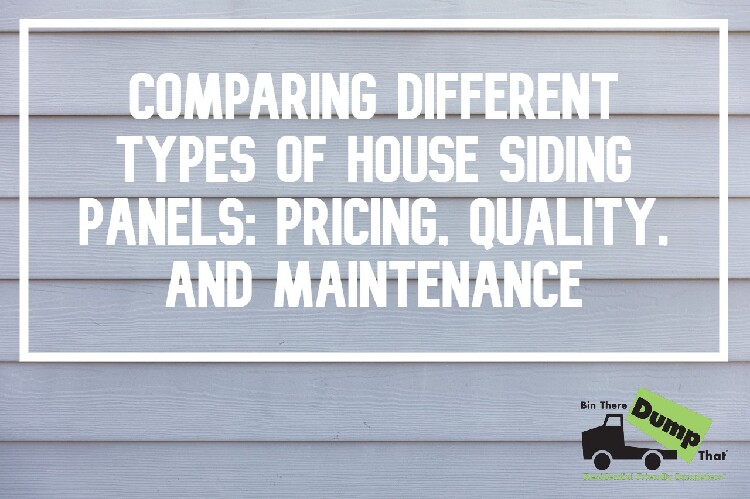
Comparing Different Types of House Siding Panels: Pricing, Quality, and Maintenance

Vinyl Siding:
Vinyl siding is a popular choice due to its affordability and low maintenance requirements. It is available in a wide range of colors and styles, making it versatile for different architectural designs. Vinyl siding panels are cost-effective, easy to install, and resistant to fading, cracking, and warping. However, the quality of vinyl siding can vary depending on the thickness and grade. Higher-quality vinyl siding typically costs more but offers better durability and longevity.
Pricing: Vinyl siding is one of the most budget-friendly options, making it an excellent choice for cost-conscious homeowners.
Quality: The quality of vinyl siding can range from basic to premium, with thicker panels offering better durability.
Maintenance: Vinyl siding is relatively low-maintenance, requiring occasional cleaning with a mild detergent and water to remove dirt and debris.
Fiber Cement Siding:
Fiber cement siding is a durable and versatile option that combines the appearance of wood with the durability of cement. Made from a mixture of cement, sand, and cellulose fibers, fiber cement siding is resistant to rot, pests, fire, and harsh weather conditions. It can mimic the look of wood, stucco, or masonry, providing homeowners with a variety of design options. Fiber cement siding is heavier than vinyl, so professional installation is recommended.
Pricing: Fiber cement siding is moderately priced, falling between vinyl and higher-end options like natural wood or stone.
Quality: Fiber cement siding is known for its durability and can last for several decades with proper maintenance.
Maintenance: Fiber cement siding requires periodic painting to maintain its appearance and protection. However, it is relatively low-maintenance compared to wood siding.

Wood Siding:
Wood siding panels offer a natural and timeless look that adds warmth and character to a home. They are available in different types of wood, including cedar, pine, and redwood, each with its unique aesthetic appeal. Wood siding requires regular maintenance to protect it from moisture, pests, and rot. Proper staining, sealing, and periodic painting are essential to maintain its appearance and longevity. With care and proper maintenance, you can even use reclaimed wood for the exterior of your home, making it a great way to recycle and reduce your carbon footprint.
Pricing: Wood siding can vary significantly in price, depending on the type of wood chosen. Cedar and redwood tend to be more expensive than pine.
Quality: Wood siding provides a high-quality and authentic look, but it requires regular maintenance to ensure its durability.
Maintenance: Wood siding demands more maintenance compared to other options. Regular inspections, staining, sealing, and painting are necessary to prevent moisture damage and maintain its visual appeal.
Metal Siding:
Metal siding, such as aluminum or steel, is a durable and long-lasting option that offers a modern and sleek appearance. It is known for its exceptional strength, weather resistance, and fire resistance. Metal siding is available in various styles, including vertical panels, shingles, or corrugated sheets, providing homeowners with versatility in design choices.
Pricing: Metal siding can vary in price depending on the type of metal used. Steel siding tends to be more affordable than aluminum or copper.
Quality: Metal siding is highly durable and can withstand harsh weather conditions, including high winds, hail, and UV exposure. It is also resistant to pests and rot.
Maintenance: Metal siding is relatively low-maintenance, requiring periodic cleaning to remove dirt and debris. It is important to inspect metal siding for any signs of rust or corrosion and address them promptly to maintain its integrity.

Insulation Value of House Siding Panels
R-Value plays a crucial role in determining the insulation capabilities of the chosen material. The R-Value measures how effectively the siding can resist heat transfer, impacting the energy efficiency of the home. Opting for siding with a higher R-Value provides better thermal resistance, helping to maintain a comfortable indoor temperature while reducing reliance on heating and cooling systems.
Improved insulation not only enhances the overall comfort of the living space but also contributes to lower energy costs by minimizing heat loss or gain through the siding. Therefore, when selecting house siding, considering the R-Value of the material is vital to ensure optimal energy efficiency and a comfortable living environment.
Now, let's address the questions:
What is the best siding to use on a house?
The best siding for a house depends on various factors, including budget, desired aesthetics, durability, and maintenance preferences. Vinyl siding is often considered the best choice for its affordability, low maintenance, and wide range of design options.
What is the cheapest exterior siding?
Vinyl siding is typically the cheapest exterior siding option available. Its affordability, coupled with its low maintenance requirements, makes it a popular choice for homeowners on a budget.

Which siding is easiest to maintain?
Vinyl siding and fiber cement siding are generally the easiest to maintain. Vinyl siding requires minimal upkeep, only needing occasional cleaning, while fiber cement siding requires periodic painting but offers excellent durability and resistance to pests and rot.
Choosing the right house siding involves considering factors such as pricing, quality, and maintenance requirements. Vinyl siding is often the most affordable and low-maintenance option, while wood siding provides a natural and authentic aesthetic at the cost of more regular maintenance. Ultimately, the best siding choice will depend on individual preferences, budget, and the desired look for your home's exterior.
No comments:
Post a Comment